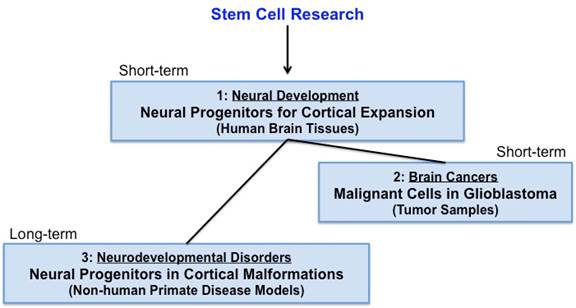One of the most prominent features of the human brain is the greatly enlarged cerebral cortex with its intricate folding, contributing to the increased behavioral repetoire and the emergence of human cognition. Neural stem cells play important roles in cortical expansion and gyrification. Malformation of the human neocortex (like microcephaly and lissencephaly) due to the defects in cell proliferation and migration usually causes neurodevelopmental disorders, such as mental retardation, autism and epilepsy. In the short term, our lab will study the special properties of human neural stem cells important for evolutionary cortical expansion during normal development (Direction 1). In the long term, we will examine how neural stem cell technology could help to correct the abnormalities associated with cortical malformation and neurodevelopmental disorders (Direction 3). Meanwhile, we intend to apply our expertise in stem cell research to explore the unique properties of malignant tumor cells in brain cancers (Direction 2).

Direction 1: Study the Properties of Neural Progenitors Important for Human Cortical Expansion during Development
During evolution, primates develop a much thicker subventricular zone (SVZ) that splits into inner and outer subdivisions. While the inner subventricular zone (ISVZ) in humans is similar to the rodent SVZ, the outer subventricular zone (OSVZ) is absent in the rodent brain and becomes the principle proliferative region in the primate cortex. Previous studies have discovered novel neurogenic progenitors, outer radial glial cells (oRGs), in the OSVZ that are important for gray matter expansion. My postdoc work identified oRG-derived oligodendrocyte precursor cells (OPCs) as an additional source of oligodendrocytes. They are abundant in the human but rare in the mouse brain, with the enhanced proliferative potential in contributing to the evolutionary white matter expansion (Huang et al., 2020). By combining single-cell RNA-seq, brain slice culture, as well as time-lapse confocal imaging, our lab will continue to search for human-specific or human-enriched neural progenitor types in the OSVZ, and study their unique properties of proliferation, migration and differentiation. Eventually, we hope to fully understand the special molecular and cellular mechanisms underlying human cortical development.
Direction 2: Study the Properties of Malignant Cells in Gliobastoma and Compare Malignant Cells with Human Embryonic Neural Progenitors
Glioblastoma is an incurable malignancy, and the main challenges underlying therapeutic failure are rooted in its complexity of cellular components and its similarity to the endogenous neural stem cells. Studies of inter-tumor heterogeneity by bulk RNA-seq have subdivided glioblastoma into subtypes; while research based on single-cell RNA-seq across different glioblastoma subtypes have uncovered major types of malignant cells. Our lab intends to precisely compare each type of malignant cells with their endogenous neural progenitor counterparts based on genomic analysis and functional studies. This research will deepen our knowledge of brain tumor formation and might discover targets of therapeutic treatment.
Direction 3: Study the Mechanisms underlying Cortical Malformations and Neurodevelopmental Disorders
Cortical malformations encompass heterogeneous groups of structural anomalies associated with complex neurodevelopmental disorders, resulting in pathologies such as intellectual disability and abnormal neurological or psychiatric conditions such as epilepsy or autism. But little is known about the mechanisms, and very limit therapeutic treatments are available. Our lab plans to apply our expertise of fundamental research on human cortical development to clinical relevant study on cortical developmental diseases. Through pathology study of cortical malformation on postmortem samples from clinics and mechanistic study of cortical malformation in non-human primate models, we aim to better understand neurodevelopmental disorders, and explore treatments to improve patients’ outcomes.

Investigator